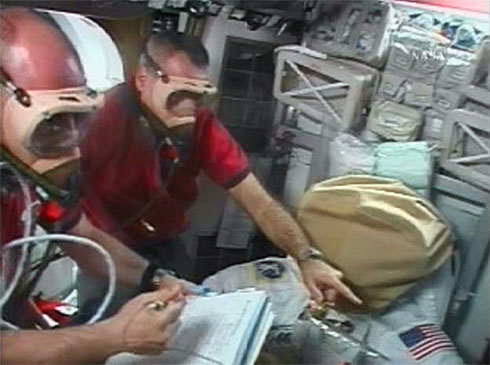[/caption]Air quality is a serious issue for any space-based activity. After all, if a harmful gas is leaked into the sealed space station, the astronauts on board cannot simply open the window to get some fresh air. The International Space Station (ISS) and stations before it (including the Russian-built Mir) have all been afflicted with poor air-quality conditions. This is a concern for astronauts and cosmonauts as their health can suffer significantly when exposed to certain chemicals accidentally leaked.
In an effort to remove the threat of harmful chemical build-up in the ISS, a new hi-tech electronic “nose” will be tested on board the ISS next month. If successful, the ENose will be fitted as standard on manned space missions, including long-term missions to the Moon and Mars…
Crewmembers on board space ships and stations will be critically aware of the risk of poor air quality. Air pollution is a huge issue at the best of times here on Earth, but we have the advantage that we can (usually) move freely to locations where air quality is better. Naturally, this might be hard if you live in a city where exhaust fumes and stagnant weather can cause problems, or if you are affected by natural disasters such as volcanic activity or wildfires (as I found out for myself last week!), but generally we can close our windows (to stop polluted air from getting in) or open them (to vent bad air out).
However, in space, you’re stuck with the air that is being circulated, meaning an emergency will quickly develop if an undetected contaminant is released. As I write this, I’m looking at the carbon monoxide detector in my office; if CO is detected it will set off an early warning beeper hopefully saving me from being overcome by the odourless gas. This is the critical thing for the space station, should an odourless gas be released into the air, the crew may not know about it until it’s too late.
So, next month, NASA will be sending an air quality early warning detector to the station. “This ENose is a very capable instrument that will increase crew awareness of the state of their air quality,” said Carl Walz, a former astronaut and director of NASA’s Advanced Capabilities Division, which funds ENose development. “Having experienced an air-quality event during my Expedition 4 mission on the space station, I wish I had the information that this ENose will provide future crews. This technology demonstration will provide important information for environmental control and life-support system designers for the future lunar outpost.”
This life-saving gadget will use 32 sensors to identify several key organic and inorganic gaseous chemicals. These gases may be released due to solvent use or before the onset of an electrical fire. The human nose can be very tolerant of high concentrations of harmful chemicals, smelling them when it is too late, so technology has to step in and detect low levels of contaminents before they become an issue. The geeky-named “ENose” will be able to detect “fractional parts per million to 10,000 parts per million,” of harmful airborne chemicals.
The ENose sensors contain polymer films that alter their electrical conductivity in response to exposure to different chemicals. Depending on the key chemicals detected, the detector’s response will depend on which sensors have been triggered. A picture will quickly emerge as to what is causing the contamination and the crew will be notified about the emerging danger. Aerosols and vapour can both be detected.
This air-sniffing piece of kit is about the size of a shoebox and weighs only nine pounds (4 kg) and draws 20 W of power. If it is successful, the ENose will most likely be integrated into future lunar colonies, then manned missions to Mars.
A previous incarnation of the ENose was tested on the ISS in 1998 for six months (according to the NASA press release), which brings up the obvious question: Why has it taken ten years to carry out more tests on this critical bit of equipment? Surely another early warning system is currently in place? As far as I can tell, there doesn’t seem to be…
Source: Computer World


Awesome idea… I think you should mention this to NASA, there needs to be some in-orbit recognition of ACDC 🙂
ENose…? The thing’s name stinks, obviously it failed to detect that. How about the “Airborn Contaminant Detection Console”. You can’t go wrong with an homage to a great rock band. Great piece of tech though. Kuduo’s to the creators.
I bet that place reeks horribly with some nasty B.O.